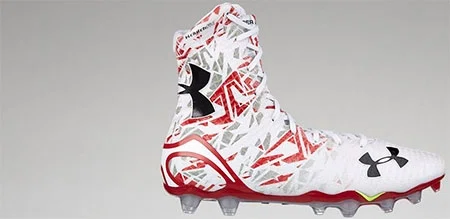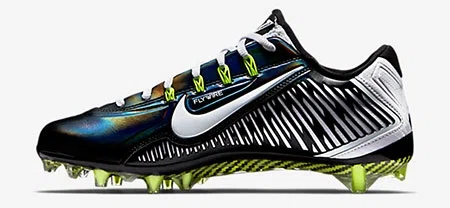Football cleats are what give players traction and grip when running and turning on the field. Cleats also provide comfort and stability, particularly to the ankles.
When it comes to football cleats, it’s important to choose carefully. Having the right pair of cleats can improve on-field performance and minimize the chance of injury, reports The New York Times. Conversely, having the wrong kind of cleats or cleats that don’t fit properly, can hamper performance and potentially lead to an injury.
So what are the best football cleats for 2015?
The best football cleat will actually vary depending on the position a player plays. It’s also important to take factors like playing surface and weather conditions into account.
Playing on natural grass in a wet climate like Washington State for instance, places different demands on cleats than playing on turf in a hot dry climate like Arizona would.
Here’s the Dealspotr breakdown of the different types of cleats.
Molded Cleats
First you need to decide between molded or detachable cleats. Molded cleats are those that are permanently attached to the outsole on the bottom of the shoe. They are good for playing on turf and grass, depending on the length and design of the cleats.
Molded cleats are often more affordable than those with detachable cleats. Molded cleats also require less maintenance than detachable ones.
Detachable Cleats
Detachable cleats feature studs that can be removed and replaced to adapt to different field conditions and different types of grass. If you play primarily on grass, than detachable cleats could be the way to go.
You should attach shorter cleats for playing on hard, dry surfaces and longer studs for wet, muddy conditions. It’s not recommended, however, to play with detachable studs on turf, as their stud configuration is better suited to grass surfaces.
Detachable cleats are available in four sizes: ½ inch, 3/8 inch, ¾ inch and 1 inch lengths. Rules regarding the size of stud permitted vary from organization to organization. Although these days more and more organizations are banning detachable cleats altogether, points out MomsTeam.com.
Also, since adapting to the subtleties of detachable cleats can take time, sometimes molded cleats are a better option, simply because they’re easier to adapt to. And since they’re less expensive than detachable cleats, molded cleats may be better for players whose feet are still growing and will require upgrading to a bigger size.
Given that each unique position on the field also has its own unique demands, it’s important to consider a player’s position when choosing cleats.

Best Cleats for Linemen
Since linemen tend to be large, heavy players who are frequently subject to high-impact contact with opponents, they need cleats that provide substantial ankle support, according to BestCleats.com.
Linemen’s cleats also typically need longer studs to penetrate deep into the field and provide grounding support to push off laterally, as well as to dig in when its time to stand ground offensively.
Linemen’s cleats should fit snugly and provide ankle support that goes part of the way up the lower leg.
Based on user reviews and online ratings on Amazon, the best football cleat for linemen are the Under Armour Men’s UA Highlight MC Football Cleats. Lightweight and with a high fit that goes midway up the calf, these cleats were designed to fit like a “second skin” by molding to your foot and ankle.
Features include:
- 3D-molded tongue for unrivaled comfort & added protection
- Foot-forming 4D Foam footbed that molds to your foot for locked in, custom fit
V56 technology designed to help prevent over-extension
UA PlasmaX plate that powers your foot’s natural motion for improved traction and stability
Lightweight bladed cleats for quick cuts, good traction, and explosiveness
At 10.8 oz. the Under Armour Men’s UA Highlight MC Football Cleats are ultra light and available in several different color schemes. They cost $129.99 at UnderArmour.com.

Best Cleats for Running Backs, Wide Receivers, Defensive Backs
Running backs, quarterbacks and other “skill” position players require cleats that provide some ankle support, although not as much as linemen.
Running back cleats should provide support for moderate contact with opponents. They also need to provide maneuverability and traction for quick takeoff on runs.
While linesmen’s cleats are ultra-high-topped, skill players typically wear mid-cut cleats.
The best football cleats for skill position players are the $130 Nike Men’s Vapor Carbon Elite TD, according to Isaac Clark of Complex.com. Players like them for their lightweight flexibility, comfort and 12-stud configuration that provides good traction for taking off or maneuvering at high speeds.
Like all cleats in the Vapor line, the Nike Men’s Vapor Carbon Elite TD has very supportive sidewalls that make it easier to corner at high speeds. The cleat also features a Dynamic Flywire to improve the upper fit and form better to the shape of the foot.
Other features include:
- A synthetic upper that provides a zero-space fit with no room for slippage
- Nano-lasered panels with less weight but more support
- A power-plate outsole that comes with carbon-fiber propulsion elements, split in the midfoot to promote natural flexibility
- TPU traction pattern that combines with the plate for explosive multidirectional traction.
At just 9.8 oz., the Vapor Carbon Elite TD is ultra-lightweight and comes with a free shipping promo code from Nike.
Conclusion
Cleats aren’t cheap, even the molded kind. So it’s always best to practice due diligence before you shop. Different players have different demands and what is the best football cleat for you ultimately depends on what kind of player you are and what kind of surfaces you play on.
While some players will always prefer the versatility afforded by playing with detachable studs, molded cleats are getting better all the time. They’re also more affordable. With the growing number of turf fields, they’re the best option for many players these days, especially those whose feet are still growing.


